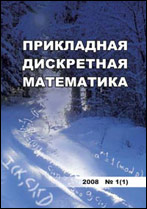|
Computational Methods in Discrete Mathematics
Median for an odd number of linear order relations and its use in group choice problems
V. N. Nefedov
Moscow Aviation Institute, Moscow, Russia
Abstract:
We consider the problem of constructing a median for an odd set of linear order relations defined on a finite set $A = \{ a_1, a_2, \ldots , a_n \}$, which is also sought in the class of linear order relations. We arrive at a similar problem when considering some group choice problems. The distance between binary relations is the Hamming distance between their adjacency matrices. In the case under consideration, the binary relation $\tilde{\rho}$, which has the minimum total distance to the given set of binary relations, is the median for these relations and, moreover, is unique. However, this median is not always transitive (and in this case is neither linear order, nor even a quasi-order), and therefore cannot be taken as a solution to a given problem. However, the median $\tilde{\rho}$ necessarily belongs to the set $LA[n]$ (of linear asymmetric binary relations on $A $), to which, in particular, all linear orders on $A $ also belong. Some properties of binary relations from $LA[n]$ are investigated. The concepts of “almost optimal” and $\Delta$-optimal relations are introduced, which are linear orders and, at the same time, exact solutions of the stated problem. Algorithms for finding them are given, based on the obtained statements about binary relations from $LA[n]$ and having polynomial computational complexity. An equivalence relation on the set $LA[n]$ is considered, which allows one to divide this set into equivalence classes, the number of which $K_n$ is much less than the number of elements in $LA[n]$. For example, $|LA[5]|=1024$, $K_5=12$. Thus, each binary relation from $LA[n]$ is equivalent to exactly one of the $K_n$ representatives of the equivalence classes and, therefore, has its main properties. But then the study of a wide class of problems can be reduced to considering a relatively small set of them. The process of finding the specified set of equivalence class representatives is illustrated for $n=2, 3, 4, 5$. A method for solving the problem posed is also given, using the representation of binary relations in the form of graphs (the method of selecting the minimum sets of contour representatives in the median $\tilde{\rho}$), which has exponential computational complexity.
Keywords:
median of relations, linear order relation, linear relations, asymmetric relations, Hamming distance, equivalence classes, group choice problem.
Citation:
V. N. Nefedov, “Median for an odd number of linear order relations and its use in group choice problems”, Prikl. Diskr. Mat., 2022, no. 57, 98–127
Linking options:
https://www.mathnet.ru/eng/pdm779 https://www.mathnet.ru/eng/pdm/y2022/i3/p98
|

|




 Contact us:
Contact us: Terms of Use
Terms of Use
 Registration to the website
Registration to the website Logotypes
Logotypes







 Citation in format
Citation in format 